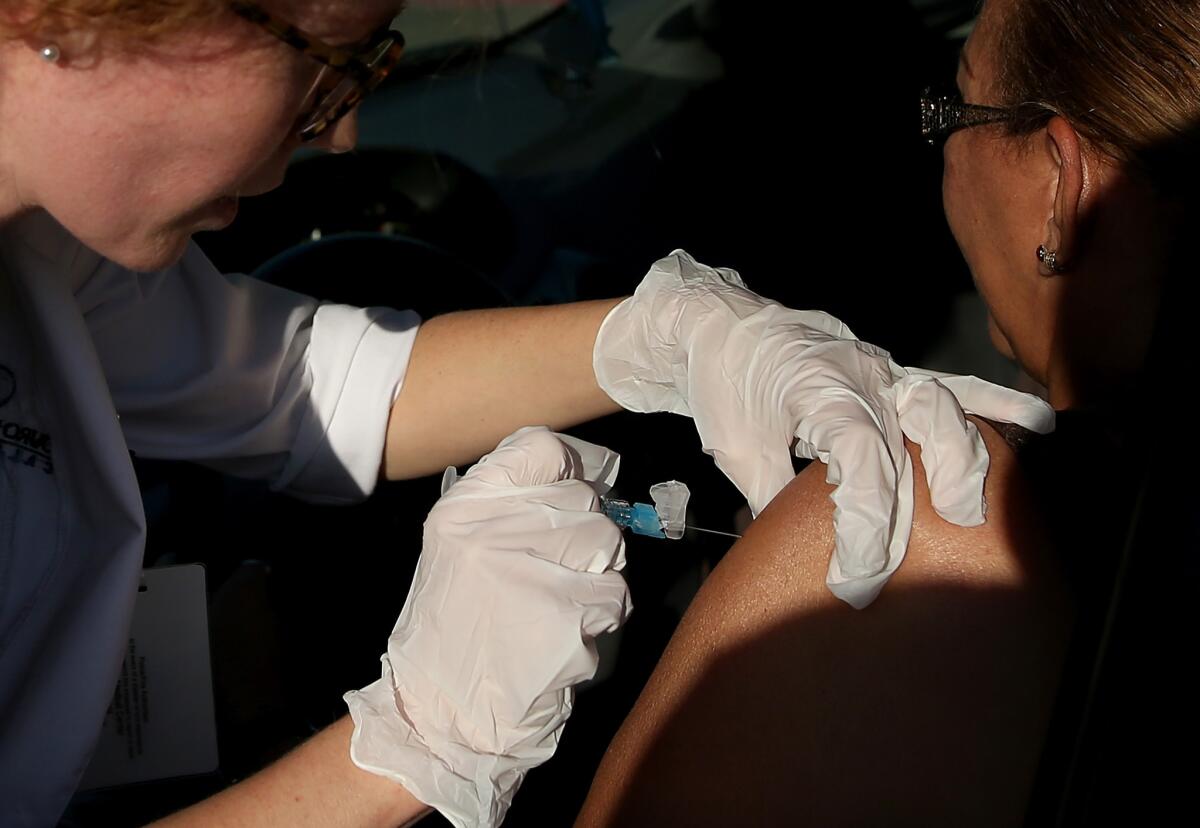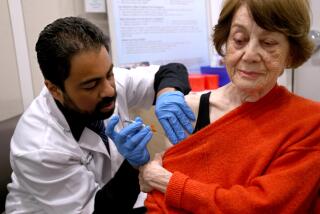A milder ‘B’ strain might be keeping California’s flu numbers low

A flu shot is administered at a drive-through clinic at Doctors Medical Center in San Pablo, Calif., on Nov. 6, 2014.
- Share via
Though more people in California have been falling sick with the flu in the past few weeks, the season so far is proving milder than in recent years.
Experts suggest several reasons: the available vaccine is a good match for the flu strains going around, the virus may not be spreading rapidly because of unusually warm weather, and the outbreak might not have peaked yet.
“In the middle of it all, it’s hard to know where we are: whether we’re in the eye of the storm or the storm has passed,” said Dr. Robert Schechter, medical officer with the immunization branch of the California Department of Public Health.
The last three flu seasons peaked in December, but February is the most common peak of the season, which can run through May.
Since the beginning of this season in October, 16 Californians under age 65 have died of the flu, according to data released Friday. At this time last year, there had been 29 deaths and two years ago, 243 deaths.
But there’s another possible explanation for the low case numbers: Influenza B.
See more of our top stories on Facebook >>
Viruses A and B infect people each winter flu season, but B strains typically cause less severe illness.
This season so far, 45% of Californians diagnosed with the flu had been infected with Influenza B, compared with 6% last year, and 7% the year prior, according to state data.
A similar trend has been seen nationally, with 32% of Americans diagnosed with flu this season testing positive for Influenza B, compared with 6% and 9% in the previous two years, respectively, according to the federal Centers for Disease Control and Prevention.
When a less severe flu strain is circulating, fewer people who are infected may be captured in the numbers, because they aren’t sick enough to go to the doctor. To be reported in the state flu numbers, a patient must be officially diagnosed by a physician and have a sample sent in for testing.
“Overall, the cases that are reported, whether mild or severe, are the tip of an iceberg,” Schechter said. “Each year the numbers we hear about are just a small proportion and ... it’s quite likely that that proportion may vary from year to year.”
The state data released Friday also show that the percentage of people in California showing up at clinics and outpatient settings with the flu increased last week over the previous week.
Some local hospitals also report that cases appear to be increasing. Together, Long Beach Memorial Medical Center, Community Hospital Long Beach and Miller Children’s & Women’s Hospital Long Beach confirmed 60 flu cases last week, compared with an average of 27 during each of the three previous weeks.
As of the first week of February, there had been seven influenza deaths in Los Angeles County so far, compared with 36 last year.
Dr. Laurene Mascola, chief of the acute communicable disease control program for the Los Angeles County Department of Public Health, was reluctant to weigh in on what’s been seen so far. As the saying goes, she said, “if you’ve seen one flu season, you’ve seen one flu season.”
“Right now we’re just happy it’s a mild season,” she said.
Because new strains haven’t emerged this season, the available vaccine includes the circulating strains and is providing strong immunity, she said. Plus, people may retain some natural immunity if they got sick from the same strains last year.
Public health officials recommend that everyone over 6 months old get a flu shot. It takes about two weeks for the vaccine to begin offering protection.
Follow @skarlamangla on Twitter for more health news.
ALSO
Driver suspected of DUI crashes into guardrail; hand severed
$17,000 bitcoin ransom paid by hospital to hackers sparks outrage
San Jose cop who taunted Black Lives Matter protesters on Twitter gets job back
More to Read
Sign up for Essential California
The most important California stories and recommendations in your inbox every morning.
You may occasionally receive promotional content from the Los Angeles Times.











